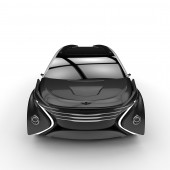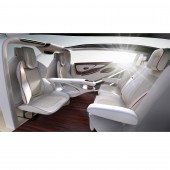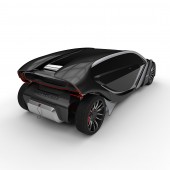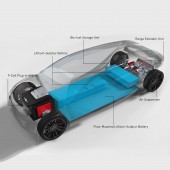Conceptum Works: Neue Klasse Luxury Multi-purpose Vehicle by Ying Hern Pow |
Home > Winners > #26783 |
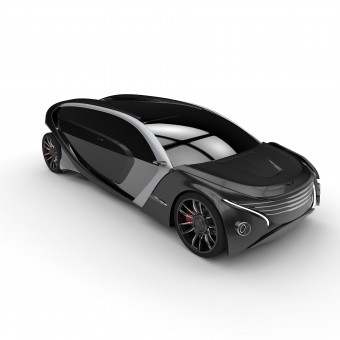 |
|
||||
| DESIGN DETAILS | |||||
| DESIGN NAME: Conceptum Works: Neue Klasse PRIMARY FUNCTION: Luxury Multi-purpose Vehicle INSPIRATION: Passengers constantly seek greater comfort and luxury while travelling from point A to point B. However, during the course of travel, social hierarchy issue exists within the cabin, particularly in the MPV (Multi-purpose Vehicle) segment. The standard 3-row cabin creates the so-called First Class, Business Class and Economy Class within the car itself, which is unhealthy for family to traverse in. This project revolves around one and only one main purpose: can a car’s cabin be meaningful? Roy M. Goodman, famous New York City mayor once said “Remember that happiness is a way of travel - not a destination.” And it is this very phrase that the FYP is inspired by and the purpose of the design can almost be felt throughout the entire concept ideation process. As a keen driver, I have always dreaded the days that I would eventually drive one of these cars, out of necessity rather than desirability. This motivated me to work on such project instead of what most young aspiring design students would do – supercars, sports cars, etc. It was a tough decision, having to select the scope of research to work on. Also, MPVs are usually bought by family men, not usually by desire, but more by requirement. Buyers of MPVs value the space and utility qualities, to ferry their wife and kids and whatever else they bring along with them for a journey, school, work alike. As a result, MPVs are generally designed to be spacious and biased towards comfort, and not so much towards driving enjoyment. After all, when you have your kids in tow, the last thing you want to do is to throw your ride into corners vigorously. The bi-products of MPVs, unfortunately, are usually their overtly bulky body style and dull image. UNIQUE PROPERTIES / PROJECT DESCRIPTION: The Neue Klasse fits itself in the people-carrier segment while demonstrating its luxurious cabin design. It establishes an entire new segment that addresses these issues with elegant solutions, while infusing Asian ideology of social interaction with a groundbreaking interior layout. The Lithium-sulphur-powe OPERATION / FLOW / INTERACTION: - PROJECT DURATION AND LOCATION: The project started in late August 2011 and finished in May 2012. It was then exhibited at both Singapore (downtown) and London (University of Ravensbourne) FITS BEST INTO CATEGORY: Vehicle, Mobility and Transportation Design |
PRODUCTION / REALIZATION TECHNOLOGY: The car fully utilises Carbon Fiber Reinforced Plastics (CFRP) as its main body structure. Weight savings have been done to make way for heavy components such as batteries and electric motor. Also, the Neue Klasse is a REEV (Range-extender Electric Vehicle) that utilizes Lithium-sulphur battery power for extended driving range. Range Extender engine powered by biofuel such as palm oil is sustainable, yet provides ample power to recharge the electric drive train. SPECIFICATIONS / TECHNICAL PROPERTIES: The body features a proportionate stance – with a height of less than 1.6 meters – and generous length and width – 5.14 and 2 meters respectively. The concept has a very long wheelbase, 3.9 meters long to be exact. TAGS: Neue Klasse, Car, MPV, Luxury, Social, Interior, Automotive, Vehicle, Design, Pow, Pow Ying Hern, RESEARCH ABSTRACT: Market research was needed to determine the market segmentation the design will be classified in. Also, it serves as a close benchmark and limitations to which the car could be designed and engineered. Through demographic usage and dimensions of rival products, the project proceeded into product differentiation in order to distinguish Neue Klasse itself from the rest of the products. A series of H-point analysis and challenge of package have been carried out to determine the project's feasibility. Finally, polls have been set up to determine the most desirable design via facebook. CHALLENGE: The most challenging part of the project is packaging of the interior. The given space is limited, yet a large part of the space has to be allocated for creature comfort, while not sacrificing the packaging of other crucial parts such as chassis, batteries, suspensions, etc. ADDED DATE: 2012-09-29 02:26:47 TEAM MEMBERS (1) : IMAGE CREDITS: Ying Hern Pow, 2012. |
||||
| Visit the following page to learn more: http://behance.net/yinghernp | |||||
| AWARD DETAILS | |
 |
Conceptum Works: Neue Klasse Luxury Multi-Purpose Vehicle by Ying Hern Pow is Winner in Vehicle, Mobility and Transportation Design Category, 2012 - 2013.· Read the interview with designer Ying Hern Pow for design Conceptum Works: Neue Klasse here.· Press Members: Login or Register to request an exclusive interview with Ying Hern Pow. · Click here to register inorder to view the profile and other works by Ying Hern Pow. |
| SOCIAL |
| + Add to Likes / Favorites | Send to My Email | Comment | Testimonials | View Press-Release | Press Kit |
Did you like Ying Hern Pow's Vehicle Design?
You will most likely enjoy other award winning vehicle design as well.
Click here to view more Award Winning Vehicle Design.


